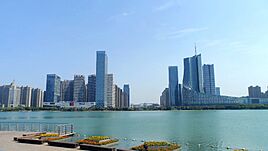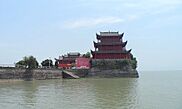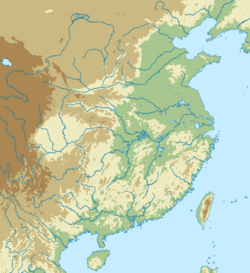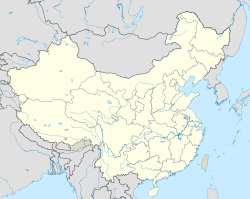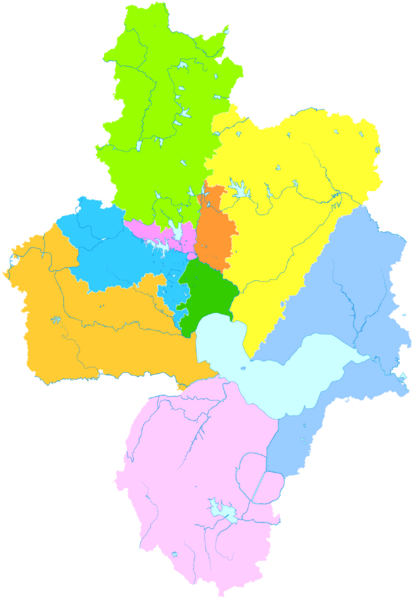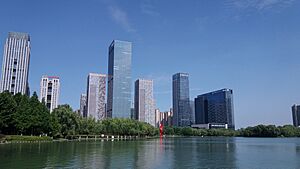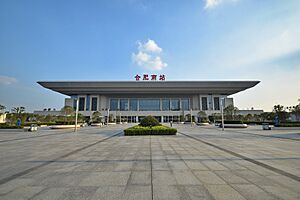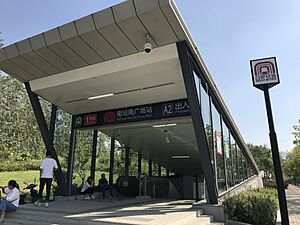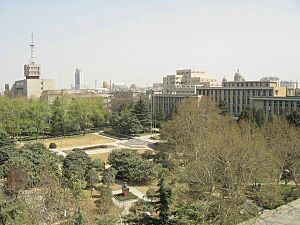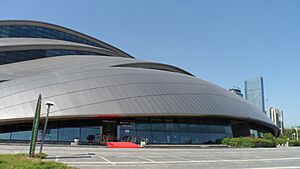Hefei facts for kids
Quick facts for kids
Hefei
合肥市
Hofei
|
|
|---|---|
|
Prefecture-level city
|
|
|
Swan Lake CBD
Baogong Park
Lord Bao Temple
Temple on Chao Lake
Hua Tuo Statue
|
|

Location of Hefei City jurisdiction in Anhui
|
|
| Country | China |
| Province | Anhui |
| County-level divisions | 7 |
| Municipal seat | Shushan District |
| Government | |
| • Type | Prefecture-level city |
| • Body | Hefei Municipal People's Congress |
| Area | |
| • Prefecture-level city | 11,434.25 km2 (4,414.79 sq mi) |
| • Urban | 838.5 km2 (323.7 sq mi) |
| • Metro | 7,055.6 km2 (2,724.2 sq mi) |
| Elevation | 37 m (123 ft) |
| Population
(2022 census)
|
|
| • Prefecture-level city | 9,465,881 |
| • Density | 827.8532/km2 (2,144.1301/sq mi) |
| • Urban | 5,118,199 |
| • Urban density | 6,104.0/km2 (15,809.3/sq mi) |
| • Metro | 7,754,481 |
| • Metro density | 1,099.053/km2 (2,846.535/sq mi) |
| GDP | |
| • Prefecture-level city | CN¥ 1.141 trillion US$ 145.0 billion |
| • Per capita | CN¥ 120,579 US$ 18,691 |
| Time zone | UTC+8 (CST) |
| Postal code |
230000
|
| Area code(s) | 551 |
| ISO 3166 code | CN-AH-01 |
| License plate prefixes | 皖A |
|
Southern magnolia (Magnolia grandiflora L.) Sweet Osmanthus (Osmanthus fragrans Lour.) Blossom of pomegranate (Punica granatum L.) |
|
| Hefei | |||||||||||||||||||||||||||
|---|---|---|---|---|---|---|---|---|---|---|---|---|---|---|---|---|---|---|---|---|---|---|---|---|---|---|---|
| Chinese | 合肥 | ||||||||||||||||||||||||||
| Postal | Hofei | ||||||||||||||||||||||||||
| Literal meaning | "Junction of the Fei Rivers" | ||||||||||||||||||||||||||
|
|||||||||||||||||||||||||||
Hefei is the capital of Anhui, China. It is a large city and the main center for politics, economy, and culture in Anhui. In 2020, about 9.3 million people lived here. The city's main urban area, including four districts and some nearby counties, was home to over 7.7 million people.
Hefei is located in the middle of Anhui province. It borders several other cities like Huainan and Chuzhou. The city is north of Chao Lake and sits on a low area that separates the Huai and Yangtze rivers. This makes it a natural hub for transportation.
The city has grown a lot in recent years, especially in its buildings and roads. Hefei is also home to the Experimental Advanced Superconducting Tokamak. This is a special experimental machine that studies magnetic fusion energy.
Hefei is a world leader in scientific research. In 2023, it ranked 13th globally for scientific output. It was 8th in the Asia-Pacific region and 6th in China. The city has many important universities, including the University of Science and Technology of China. This university is one of the top 100 public research universities in the world.
Contents
History of Hefei
From the 8th to the 6th centuries BC, Hefei was a place with many small states. Later, it became part of the Chu kingdom. Many old things from this time have been found here by archaeologists. The name 'Hefei' was first used for a county in the area around 200 BC, during the Han dynasty.
In the 3rd century AD, a famous battle called the Battle of Xiaoyao Ford happened in Hefei. A general named Zhang Liao from the Wei state led 800 soldiers. They defeated a much larger army of 200,000 from Wei's rival state, Wu. After this, there were many years of fighting in Hefei between Wu and Wei.
Between the 4th and 6th centuries AD, this area was an important border. It was often fought over by states from the north and south of China. Because of this, its name and how it was governed changed often. During the Sui dynasty (581–618) and Tang dynasty (618–907) periods, it became the main city of Lu prefecture. It kept this name until the 15th century.
The city we see today started during the Song dynasty (960–1126). The older Hefei was a bit farther north. In the 10th century, Hefei was briefly the capital of the independent Wu kingdom. It was also an important center for the Southern Tang state.
After 1127, Hefei became a key defense point for the Southern Song dynasty. This was during their wars against the Jin invaders. It also became a busy trading center between the two states.
When the Chinese Republic was founded in 1911, the city was officially named Hefei. It was known as Luchow during the Ming dynasty and Qing dynasty (from the 14th to 19th centuries). Hefei was the temporary capital for Anhui province from 1853 to 1862. It was renamed Hefei County in 1912. After China won the Second Sino-Japanese War in 1945, Hefei became the permanent capital of Anhui.
Before World War II, Hefei was mainly an administrative center. It was also a local market for the rich farming land to its south. Farmers brought grain, beans, cotton, and hemp here. People also made handmade goods like cloth, leather, and ironware.
The building of the Tianjin–Pukou railway in 1912, which was farther east, made Hefei less important for a while. Much of its trade moved to Bengbu. However, from 1932 to 1936, a Chinese company built a new railway. This railway connected Hefei to Yuxikou (near Wuhu) in the southeast and to the Huai River at Huainan in the north. This new railway helped Hefei's economy a lot. It allowed more goods to be sent to Wuhu and Nanjing.
Even though Hefei was a quiet market town with only about 30,000 people in the mid-1930s, its population grew more than tenfold in the next 20 years. Its role as a government center became stronger when the provincial government moved there in 1945. But much of its new growth came from becoming an industrial city. Hefei was officially named the provincial capital in 1952.
A cotton mill opened in 1958. A power plant, using coal from Huainan, was built in the early 1950s. Hefei also started making industrial chemicals and chemical fertilizers. In the late 1950s, an iron and steel factory was built. The city also developed factories for machine tools, engineering, and farm machinery. It now has an aluminum industry and many light industries.
Hefei's growth was boosted by the "Third Front construction" plan. In 1970, the University of Science and Technology of China moved to Hefei. This is one of the best technology universities in the country. In 1978, the Chinese Academy of Sciences opened a branch in Hefei. Several electronics research centers also moved from Beijing to Hefei in the early 1980s. These new schools and research centers helped Hefei become a city focused on new ideas and technology.
In 1991, Hefei was one of the first Chinese cities to create a High-Tech Industrial Zone. A period of fast growth began in 2005. The city's leader, Sun Jinlong, started a plan to build the city around industries. He focused on cars, electric appliances, and manufacturing. The city government worked hard to attract businesses to Hefei. Sun also started building new neighborhoods, improving roads, and creating a new international airport. Hefei's economy grew faster than any other provincial capital in China during his time.
Since the 2010s, Hefei has developed high-tech industries. It now has an economy driven by new ideas and inventions. This includes areas like semi-conductors and alternative energy.
Geography and Climate
Location of Hefei
Hefei is located about 130 kilometers (81 miles) west of Nanjing. It is in the south-central part of Anhui province. Chao Lake, a large lake, is about 15 kilometers (9.3 miles) southeast of the city. It is one of the biggest fresh water lakes in China. Sadly, the lake has been polluted with nitrogen and phosphorus in recent years. However, the situation is getting better because the government and people are working to clean it up.
Hefei's Climate
Hefei has a humid subtropical climate. This means it has four clear seasons. The average temperature in Hefei is 16.6°C (61.9°F) each year. It gets a bit more than 1,000 millimeters (39 inches) of rain annually. Most of the rain falls from May through August.
Winters are wet and cold. In January, temperatures often drop just below freezing, with an average of 2.8°C (37.0°F). Snow falls sometimes, but it is usually light. Cold air from Siberia can bring snow and heavier snowfall in winter months.
Springs are generally nice but can be unpredictable. Summers are hot and humid. In July, the average temperature is 28.6°C (83.5°F). From June to September, daily temperatures can reach or go above 37°C (99°F) with high humidity. Autumn in Hefei gets cooler and drier. The city gets about 1,868 hours of sunshine each year. The lowest temperature ever recorded since 1951 was −20.6°C (−5.1°F) on January 6, 1955. The highest was 41.1°C (106.0°F) on July 27, 2017.
| Climate data for Hefei (1991–2020 normals, extremes 1951–present) | |||||||||||||
|---|---|---|---|---|---|---|---|---|---|---|---|---|---|
| Month | Jan | Feb | Mar | Apr | May | Jun | Jul | Aug | Sep | Oct | Nov | Dec | Year |
| Record high °C (°F) | 20.7 (69.3) |
27.5 (81.5) |
30.4 (86.7) |
34.7 (94.5) |
36.4 (97.5) |
37.8 (100.0) |
41.1 (106.0) |
41.0 (105.8) |
38.6 (101.5) |
39.9 (103.8) |
30.1 (86.2) |
23.7 (74.7) |
41.1 (106.0) |
| Mean daily maximum °C (°F) | 7.2 (45.0) |
10.2 (50.4) |
15.5 (59.9) |
21.9 (71.4) |
27.1 (80.8) |
29.7 (85.5) |
32.6 (90.7) |
32.1 (89.8) |
28.2 (82.8) |
22.9 (73.2) |
16.4 (61.5) |
9.9 (49.8) |
21.1 (70.1) |
| Daily mean °C (°F) | 3.1 (37.6) |
5.7 (42.3) |
10.6 (51.1) |
16.8 (62.2) |
22.2 (72.0) |
25.6 (78.1) |
28.6 (83.5) |
27.9 (82.2) |
23.6 (74.5) |
17.9 (64.2) |
11.4 (52.5) |
5.3 (41.5) |
16.6 (61.8) |
| Mean daily minimum °C (°F) | −0.1 (31.8) |
2.2 (36.0) |
6.6 (43.9) |
12.4 (54.3) |
17.8 (64.0) |
21.9 (71.4) |
25.4 (77.7) |
24.7 (76.5) |
20.1 (68.2) |
13.9 (57.0) |
7.4 (45.3) |
1.7 (35.1) |
12.8 (55.1) |
| Record low °C (°F) | −20.6 (−5.1) |
−14.1 (6.6) |
−7.3 (18.9) |
−0.4 (31.3) |
6.2 (43.2) |
12.2 (54.0) |
17.9 (64.2) |
15.8 (60.4) |
10.8 (51.4) |
1.5 (34.7) |
−5.1 (22.8) |
−13.5 (7.7) |
−20.6 (−5.1) |
| Average precipitation mm (inches) | 47.4 (1.87) |
52.8 (2.08) |
76.3 (3.00) |
83.7 (3.30) |
90.1 (3.55) |
158.5 (6.24) |
185.1 (7.29) |
138.7 (5.46) |
70.3 (2.77) |
51.6 (2.03) |
54.6 (2.15) |
33.7 (1.33) |
1,042.8 (41.07) |
| Average precipitation days (≥ 0.1 mm) | 9.0 | 8.8 | 10.3 | 9.8 | 10.4 | 10.5 | 11.8 | 11.9 | 8.1 | 8.3 | 8.2 | 6.8 | 113.9 |
| Average snowy days | 4.3 | 2.6 | 1.1 | 0 | 0 | 0 | 0 | 0 | 0 | 0 | 0.5 | 1.5 | 10 |
| Average relative humidity (%) | 75 | 74 | 71 | 70 | 71 | 77 | 80 | 81 | 77 | 74 | 75 | 73 | 75 |
| Mean monthly sunshine hours | 109.2 | 113.7 | 143.2 | 173.9 | 182.9 | 155.9 | 186.2 | 176.8 | 150.0 | 151.3 | 140.4 | 126.9 | 1,810.4 |
| Percent possible sunshine | 34 | 36 | 38 | 45 | 43 | 37 | 43 | 43 | 41 | 43 | 45 | 41 | 41 |
| Source: China Meteorological Administration | |||||||||||||
Air Quality
Air quality in Hefei often gets worse in May and June. This is because farmers outside the city burn their fields to prepare for planting new crops. This creates smoke that covers the city.
Population and City Areas
Population Growth
| Historical population | ||
|---|---|---|
| Year | Pop. | ±% |
| 1953 | 183,570 | — |
| 1964 | 431,490 | +135.1% |
| 1982 | 535,681 | +24.1% |
| 1990 | 714,242 | +33.3% |
| 2000 | 1,549,476 | +116.9% |
| 2010 | 3,098,727 | +100.0% |
| 2020 | 5,055,978 | +63.2% |
| Source: Census in China | ||
Most people in Hefei are Han Chinese. There are also a small number of Hui Chinese living in the city, and they have a few mosques. Many people in the city are migrant workers who have moved from other parts of Anhui province.
City Administration
The city of Hefei is divided into 9 main areas. These include 4 city districts, 1 county-level city, and 4 counties.
Here is a table showing the areas and populations of Hefei's subdivisions:
| Map | ||||||||||||
|---|---|---|---|---|---|---|---|---|---|---|---|---|
| Code | English Name | Chinese | Pinyin | Area (km2) | Main Office | Postal Code | Subdivisions | |||||
| Subdistricts | Towns | Townships | Ethnic townships | Communities | Villages | |||||||
| 340100 | Hefei | 合肥市 | Héféi Shì | 11434.25 | Shushan District | 230000 | 45 | 65 | 19 | 1 | 736 | 1102 |
| 340102 | Yaohai District | 瑶海区 | Yáohǎi Qū | 142.90 | Mingguang Road Subdistrict (明光路街道) | 230000 | 13 | 2 | 1 | 118 | 18 | |
| 340103 | Luyang District | 庐阳区 | Lúyáng Qū | 139.32 | Bozhou Road Subdistrict (亳州路街道) | 230000 | 11 | 1 | 84 | 14 | ||
| 340104 | Shushan District | 蜀山区 | Shǔshān Qū | 261.36 | Sanli'an Subdistrict (三里庵街道) | 230000 | 8 | 2 | 92 | 17 | ||
| 340111 | Baohe District | 包河区 | Bāohé Qū | 294.94 | Luogang Subdistrict (骆岗街道) | 230000 | 7 | 2 | 77 | 38 | ||
| 340121 | Changfeng County | 长丰县 | Chángfēng Xiàn | 1928.45 | Shuihu (水湖镇) | 231100 | 8 | 6 | 80 | 193 | ||
| 340122 | Feidong County | 肥东县 | Féidōng Xiàn | 2205.92 | Dianbu (店埠镇) | 231600 | 10 | 4 | 95 | 249 | ||
| 340123 | Feixi County | 肥西县 | Féixī Xiàn | 2082.66 | Shangpai (上派镇) | 231200 | 12 | 6 | 1 | 90 | 241 | |
| 340124 | Lujiang County | 庐江县 | Lújiāng Xiàn | 2347.48 | Lucheng (庐城镇) | 231500 | 17 | 38 | 194 | |||
| 340181 | Chaohu | 巢湖市 | Cháohú Shì | 2031.22 | Woniushan Subdistrict (卧牛山街道) | 238000 | 6 | 11 | 1 | 62 | 138 | |
Hefei's Economy
In 2021, Hefei's economy (GDP) was about 1.14 trillion Chinese Yuan. This is around 145 billion US dollars. The average income per person in the city was about 121,187 Yuan (US$18,784). This puts Hefei among the top 20 cities in China for income per person. In 2023, the city's GDP grew to 1.26 trillion Chinese Yuan.
Government Investments
Hefei's city government is very involved in business. It owns many companies and invests a lot of money. This approach has helped the city's economy grow and change its main industries.
In 2008, the local government spent 3.5 billion US dollars. They bought a large part of BOE Technology. This company has since become a world leader in making parts for electronics. It is the world's biggest maker of liquid crystal displays (LCDs) and flexible screens.
Also in 2008, Hefei invested a lot in iFlytek. This company develops voice-recognition technology. It started from the USTC.
The local government also invested heavily in NIO, an electric car company. In 2020, NIO was almost out of money. Hefei bought a 25% share in the company for 7 billion Chinese Yuan. NIO moved its main office to Hefei. The government helped the company get loans from local banks to grow its supply chains. By 2022, NIO became China's most successful electric vehicle maker.
Transportation in Hefei
Hefei has been the capital of Anhui since 1945. It is a natural center for transportation. The city is north of Chao Lake and sits on a low area between the Huai River and Yangtze rivers. From Hefei, it is easy to travel by water through the lake to the Yangtze River, across from Wuhu.
Train Stations
Hefei has two main train stations. The newest one is Hefei South railway station. Most high-speed trains use this station. The other station is Hefei railway station, which is smaller and older.
There are also smaller stations in nearby towns. These include Feidong Station, Feixi Station, and Chaohu Station. These stations help people travel between the smaller towns and the main city.
Hefei's Airport
Hefei Xinqiao International Airport opened on May 30, 2013. It replaced the old Hefei Luogang International Airport. This new airport is in the northwestern part of Hefei City. The first flight to arrive was from Beijing Capital International Airport. The first flight to leave went to Shanghai Pudong International Airport.
Hefei Xinqiao International Airport has flights to major cities in China and other countries. These include Hong Kong, Singapore, Seoul, Osaka, and Frankfurt.
Subway System
The Hefei Metro is a train network that is being built. It will serve both city and rural areas of Hefei. Line 1 is 24 kilometers (15 miles) long and opened in December 2016.
Construction for Line 2 began in February 2013. It runs along major roads and connects to the city center. It also links to a place where passengers can take a bus to Hefei Xinqiao International Airport. Line 2 opened in December 2017.
Line 3 started construction in November 2015 and opened in December 2019. It connects different parts of the city, from vocational schools to universities. Line 4 opened in December 2021. The south part of Line 5 opened in December 2020. The north part was expected to open by the end of 2022.
Hefei plans to build 12 more metro lines. They also plan 4 lines to connect to nearby cities and 3 tram lines. The goal is to finish these projects by 2030.
Bus System
Hefei has a large public bus system. This includes eight special lines for bus rapid transit. There are also some bus lines that run only at certain times or have long waits between buses.
Research and Universities
Scientific Research
Hefei is very important for scientific research in China. It has seven national laboratories, which is the second highest number after Beijing. These include:
- The National Synchrotron Radiation Laboratory
- The Hefei National Laboratory for Physical Sciences at the Microscale
- The Institute of Solid State Physics
- The Institute of Plasma Physics
- The Institute of Intelligent Machines
- The High Magnetic Field Laboratory (started in 2008)
- The Anhui Institute of Optics and Fine Mechanics
All these institutes are part of the Hefei Institutes of Physical Science. This group belongs to the Chinese Academy of Sciences.
Hefei is also home to the Experimental Advanced Superconducting Tokamak. This is an experimental machine that studies magnetic fusion energy.
In 2015, the No. 105 Hospital of the People's Liberation Army in Hefei reportedly did the first human trials using CRISPR genome editing.
As of 2017, Hefei had 60 universities and over 564 research institutes. Hefei is a world leader in scientific research. In 2023, it was ranked 13th globally for scientific output. It was also named one of China's four national science centers in the country's 14th Five-Year Plan.
Universities in Hefei
Hefei has many important universities. These include:
- University of Science and Technology of China (USTC)
- Hefei University of Technology (HFUT)
- Anhui University (AHU)
- Anhui Agricultural University (AHAU)
- Anhui Medical University (AHMU)
- Anhui University of Chinese Medicine (AUCM)
- Anhui Jianzhu University (AHJU)
- Hefei Normal University (HNU)
- Hefei University (HU)
- Beihang University (BUAA) – Hefei Campus
- National University of Defense Technology (NUDT) – Hefei Campus
- Beijing Foreign Studies University (BFSU) – Hefei Campus
- Tianjin University (TJU) – Hefei Graduate School
- Peking University (PKU) – Hefei Graduate School
- Tsinghua University (THU) – Hefei Institute of Public Safety Research
The University of Science and Technology of China is especially notable. It is one of the top 100 public research universities in the world.
Sports in Hefei
Hefei used to have its own football (soccer) team called Anhui Jiufang. In the 2007–08 season, they were promoted to the Chinese Football Association Jia League. This is the second highest level of football in China. The team was later acquired by another club in 2011.
Places to Visit
- Chao Lake: This is the largest lake in Anhui and one of China's five major freshwater lakes.
- Sanhe Town: An old town with a history of over 2,500 years.
- Xiaoyaojin Park: A public park built on the ancient site of the Battle of Xiaoyao Ford.
- Temple of Lord Bao: Built in 1066 near the tomb of Lord Bao, a famous judge.
- Li Hongzhang's Former Residence: A historic house built in the late 1800s and restored in the 1990s.
- Hui Garden: A beautiful garden that opened to the public in September 2001.
- Hefei Olympic Sports Center Stadium: A large football stadium that can hold 60,000 people.
- Hefei Grand Theatre: An opera house where performances are held.
Famous People from Hefei
- Bao Zheng (999–1062): A government official and judge from the Northern Song dynasty. He is known for his wisdom and fairness.
- Li Hongzhang (1823–1901): A very important government official and diplomat in the late Qing dynasty.
- Liu Mingchuan (1836–1896): A statesman during the late Qing dynasty and the first governor of Taiwan.
- Duan Qirui (1865–1936): The temporary leader of the Republic of China from 1924 to 1926.
- Yang Chen-Ning (born 1922): A Nobel Physics Prize winner in 1957. He was one of the first Chinese people to win a Nobel Prize.
- Li Keqiang (1955–2023): He served as the Premier of China from 2013 to 2023.
- Yang Yuanqing (born 1964): The Chairman of the Board of Lenovo, a big technology company.
- Jin Jing (born 1981): A Paralympic fencer.
- Xu Song (born 1986): A Chinese singer.
- Chen Xiao (born 1987): An actor.
- Yang Yang (born 1991): An actor.
- Hu Bingqing (born 1992): An actress.
Sister Cities
Hefei has "sister city" relationships with many cities around the world. These partnerships help promote cultural exchange and friendship.
 Kurume, Fukuoka, Japan (1980)
Kurume, Fukuoka, Japan (1980) Freetown, Sierra Leone (1984)
Freetown, Sierra Leone (1984) Bujumbura, Burundi (1986)
Bujumbura, Burundi (1986) Columbus, Ohio, United States (1988)
Columbus, Ohio, United States (1988) Aalborg, Denmark (1989)
Aalborg, Denmark (1989) Lleida, Catalonia, Spain (1998)
Lleida, Catalonia, Spain (1998) Wonju, Gwandong, South Korea (2002)
Wonju, Gwandong, South Korea (2002) Darebin, Victoria, Australia (2003)
Darebin, Victoria, Australia (2003) Belfast, Northern Ireland, United Kingdom (2005)
Belfast, Northern Ireland, United Kingdom (2005) Osnabrück, Lower Saxony, Germany (2006)
Osnabrück, Lower Saxony, Germany (2006) Ufa, Bashkortostan, Russia (2016)
Ufa, Bashkortostan, Russia (2016)
Images for kids
See also
 In Spanish: Hefei para niños
In Spanish: Hefei para niños


